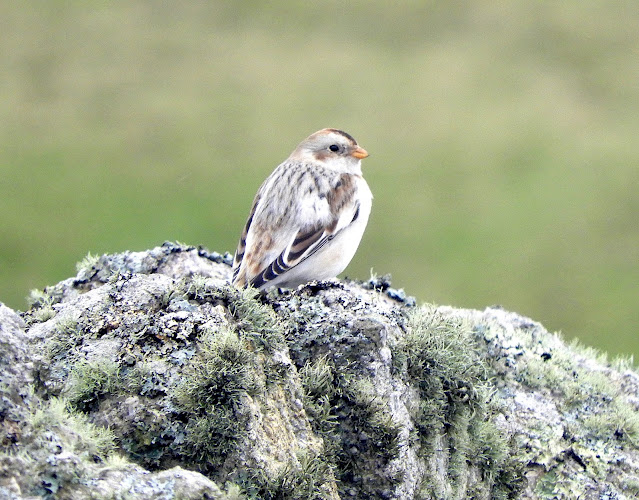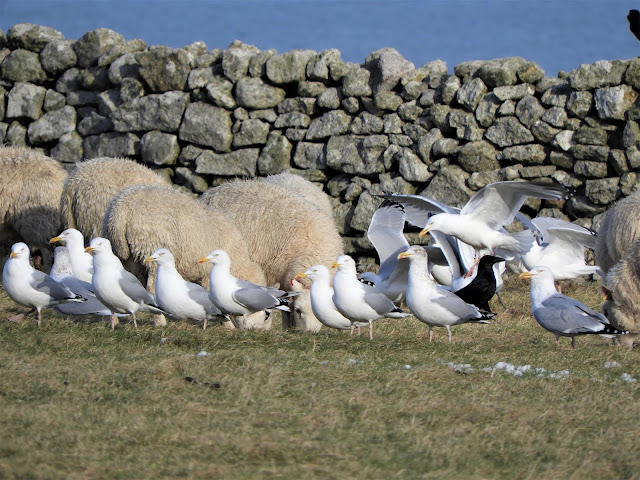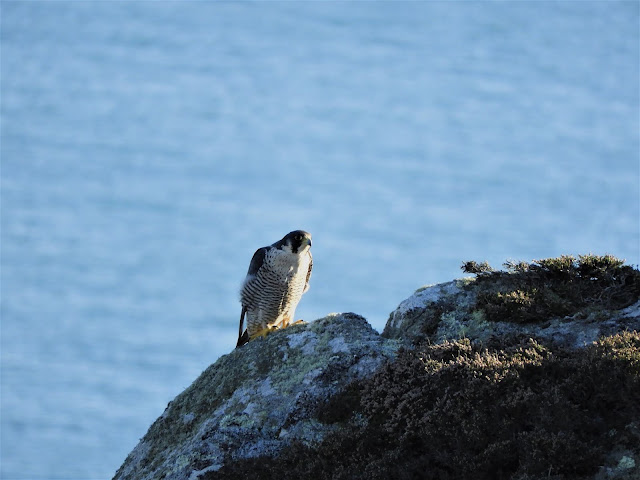Here's the latest from our man on the spot, Warden Dean Woodfin Jones...
The last week and a bit has been a breezy one, with the winds picking up from the south-west come the evening of the 15th – conditions which have pretty much continued for most of this period other than a few glorious days over the weekend. Luckily it has been a reasonably dry period throughout, though the island did receive a prolonged spell of heavy rain spanning the afternoon of the 19th to the afternoon of the 20th, at which point the clouds parted, the winds dropped to a light SW breeze and temperatures rose to a more comfortable 12°C – conditions which spurred on the first proper movement of Meadow Pipits (42) of the spring, the first Grey Wagtail to fly overhead, and a trickle of other migrants, including Stonechat, Pied Wagtail and Goldfinch. Sunday the 22nd was similar, with more beautiful early spring weather and a further movement of Meadow Pipits (47) and Skylarks (43) throughout the morning. Then, just as the migrants were getting going, the winds again picked up to gale force on the 23rd and into the 24th, peaking at gusts of 57mph from the south-west.
 |
| Early spring met winter in a soggy South West Field, with a Rock Pipit (left) and Meadow Pipit, 21 Feb © Dean Jones |
Rare gulls once again stole the show, with a second-winter Yellow-legged Gull on Ackland's Moor on the 20th topping the bill for this period. Other star larids included a stunning adult Little Gull foraging behind Rat Island on the 15th and a ‘Northern’ argentatus Herring Gull sheltering from the gales in Lower Lighthouse Field on the 20th.
 |
| Second-winter Yellow-legged Gull (upper centre) with nearby Herring and Great Black-backed Gulls, 20 Feb © Dean Jones |
 |
| Northern Herring Gull, Lower Lighthouse Field, 20 Feb © Dean Jones |
The three Lapland Buntings which arrived on 4th Feb are still hanging on in High Street Field, joined briefly on the 18th by two more birds on their way north (total five birds on this date). The Snow Bunting has still been making use of Old Light track on some days, and the first two Reed Buntings of the year dropped into Quarter Wall on the 17th.
 | ||
| The original trio of Lapland Buntings in High Street Field on 16 Feb… |
 |
| It has been such a privilege to spend the month with these beautiful buntings © Dean Jones |
Offshore there has also been a small but noticeable passage of Gannets and gulls, the latter mainly Herring Gulls and Lesser Black-backed Gulls, including a number of Lundy breeders which were seen defending breeding territories along the east coast on the 21st and 22nd. A decent flock of 733 Kittiwakes was noted offshore at the start of the period, but they quickly disappeared as the winds picked up, resulting in just a handful of birds being logged since the 19th. Guillemot and Fulmar have again been visiting their ledges periodically, and 252 Razorbills were rafting just offshore from their breeding ledges along South West Point on the beautiful, calm morning of the 22nd.
Other birds of note were up to nine Red-throated Divers on five dates, the Great Northern Diver either in the Landing Bay or offshore from the Terrace, 24 Teal on Pondsbury on the 21st, up to three Water Rail most days, a single Golden Plover on the 20th, 15 Snipe on Ackland's Moor on the evening of the 18th, singles of Woodcock on 19th and 21st, a first-winter Common Gull in Barton Field on the 21st and two Woodpigeon in Millcombe on the 19th.
The long-staying Coal Tit and Firecrest
are still going strong between Millcombe and Quarter Wall Copse, the
Firecrest treating the Warden to a few verses of song from the Millcombe
pines on the 21st.
 |
| The long-staying Coal Tit – you can still make out the yellow flush to the bird's cheeks, which suggest that it could be of Irish origin (race hibernicus) © Dean Jones |
Up to two Redwing, 11 Blackbird and eight Song Thrush (four of which were in song in Millcombe and St Helen's on the 22nd) were logged throughout, a single Linnet flew over the Village on the 22nd, and the first Goldcrest of the year was calling away in Quarter Wall Copse on the 16th.

























